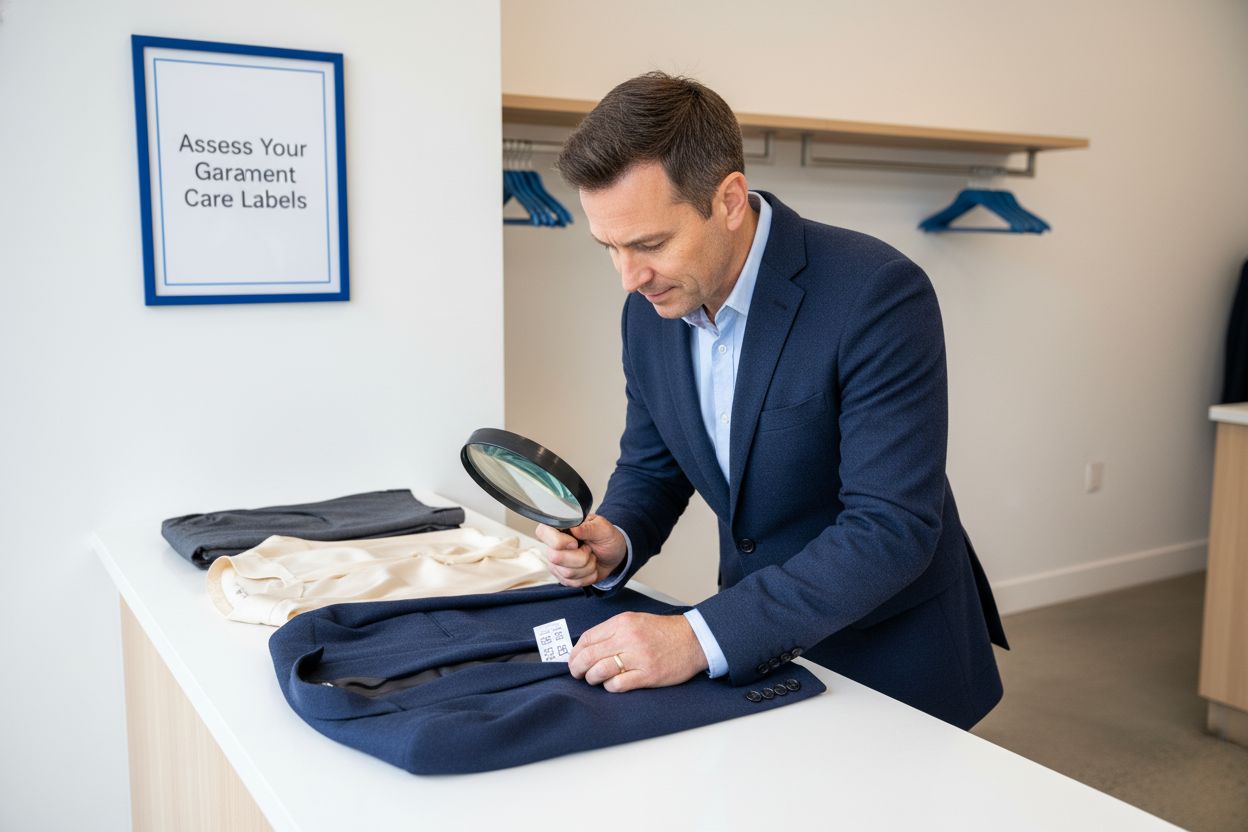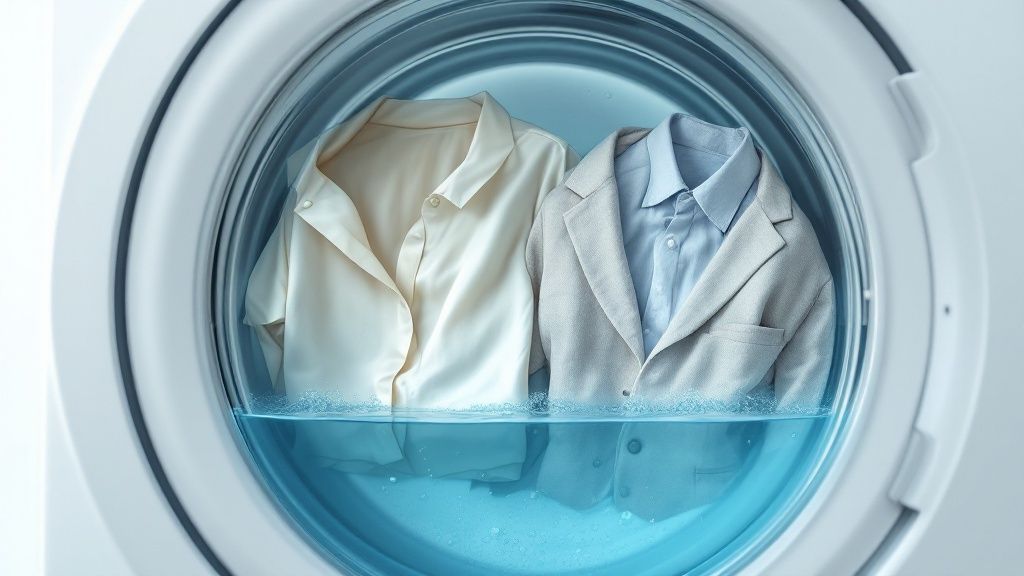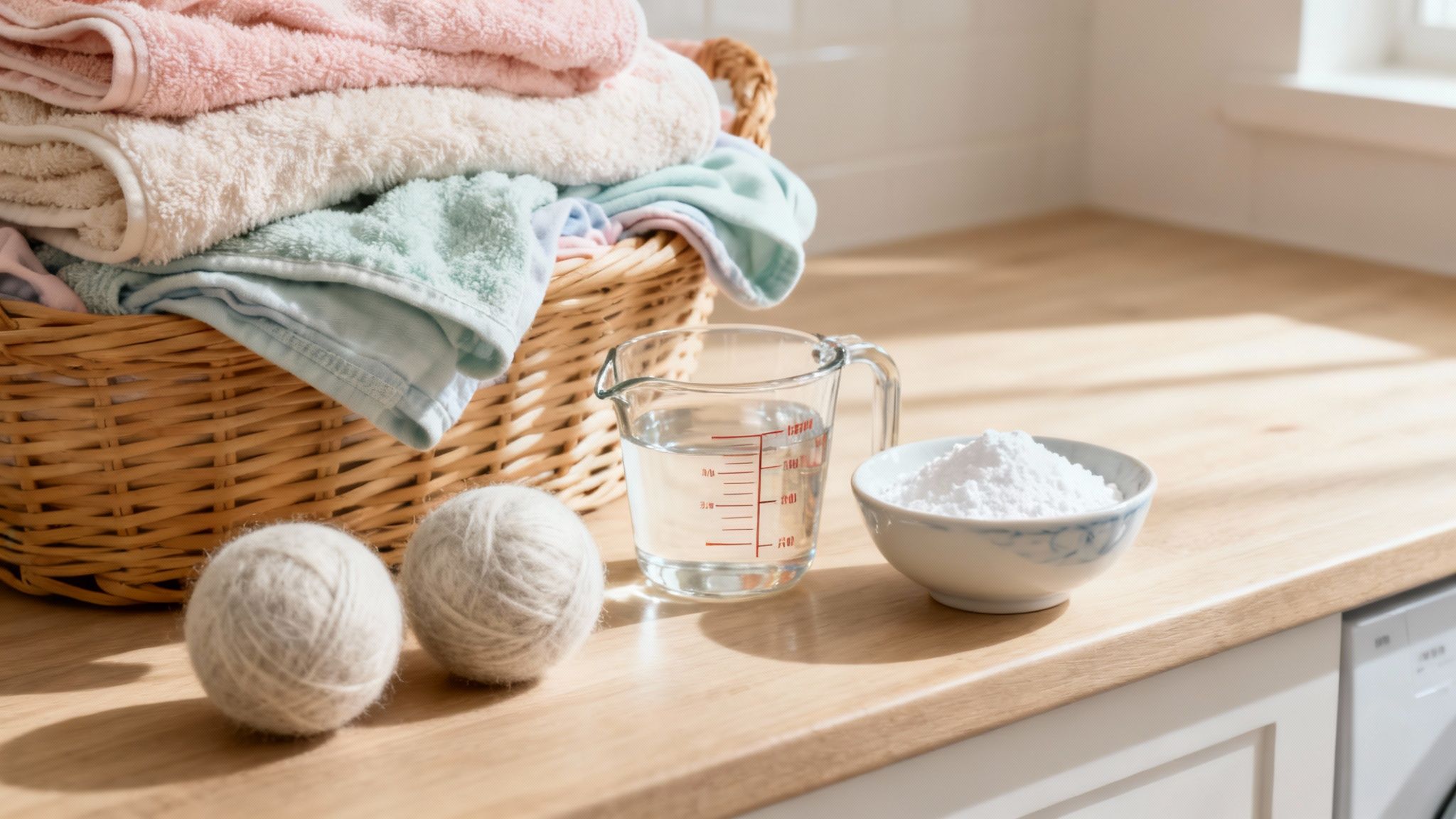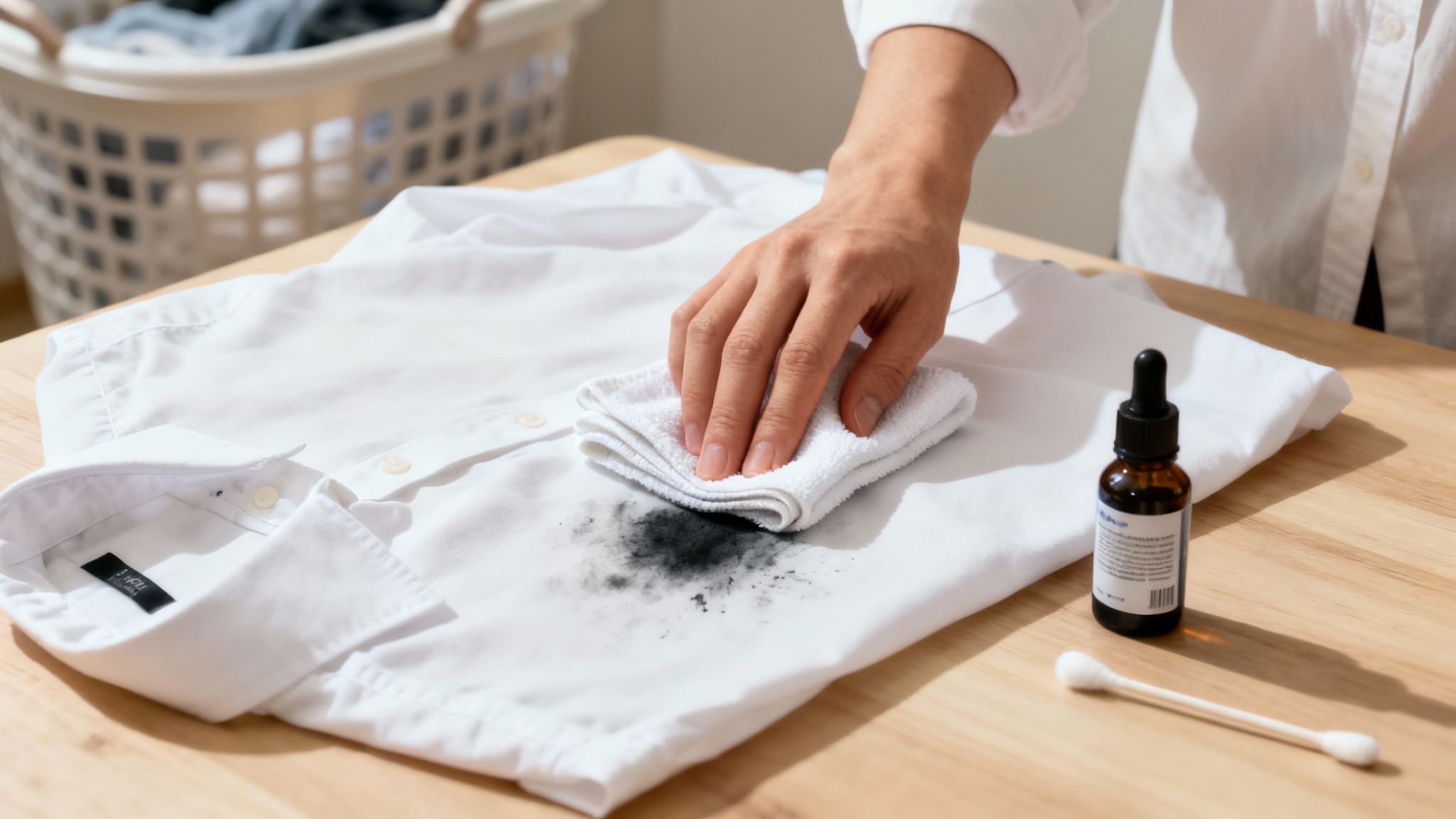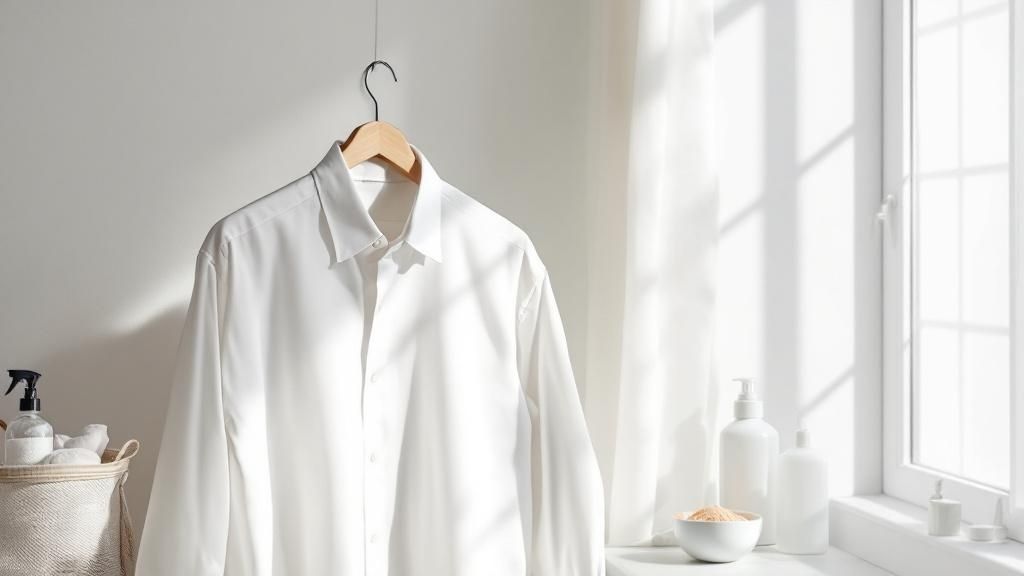How to Remove Sweat Stains From Any Fabric
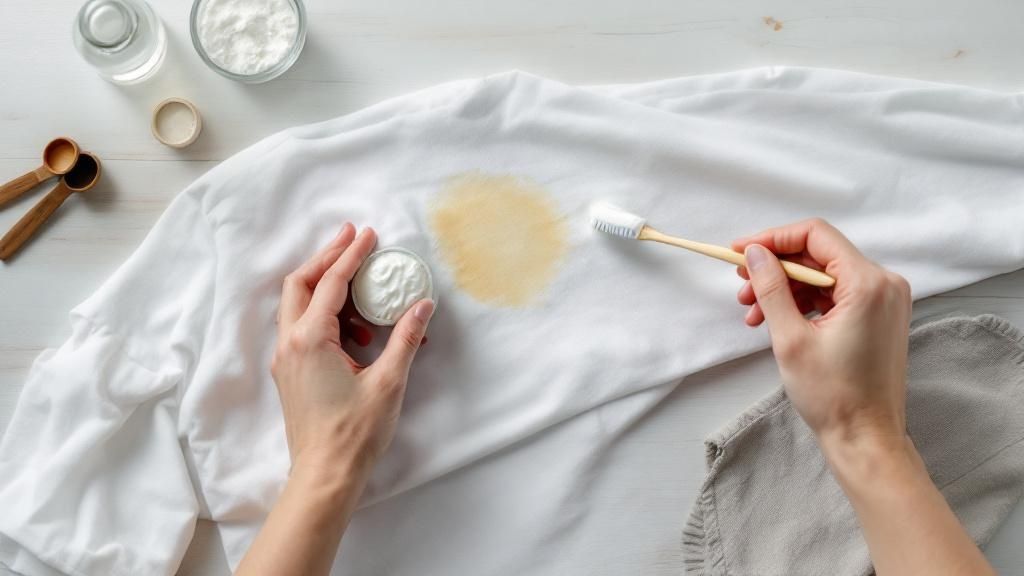
So you've noticed those dreaded yellow pit stains on your favorite white shirt. Before you do anything else, know this: tossing it straight into the wash is the worst move you can make. The secret to actually getting rid of sweat stains for good is all about pre-treating. A little work upfront breaks down the stain, letting your washer handle the rest. Master this, and you'll rescue countless shirts from the rag pile.
What Really Causes Yellow Sweat Stains
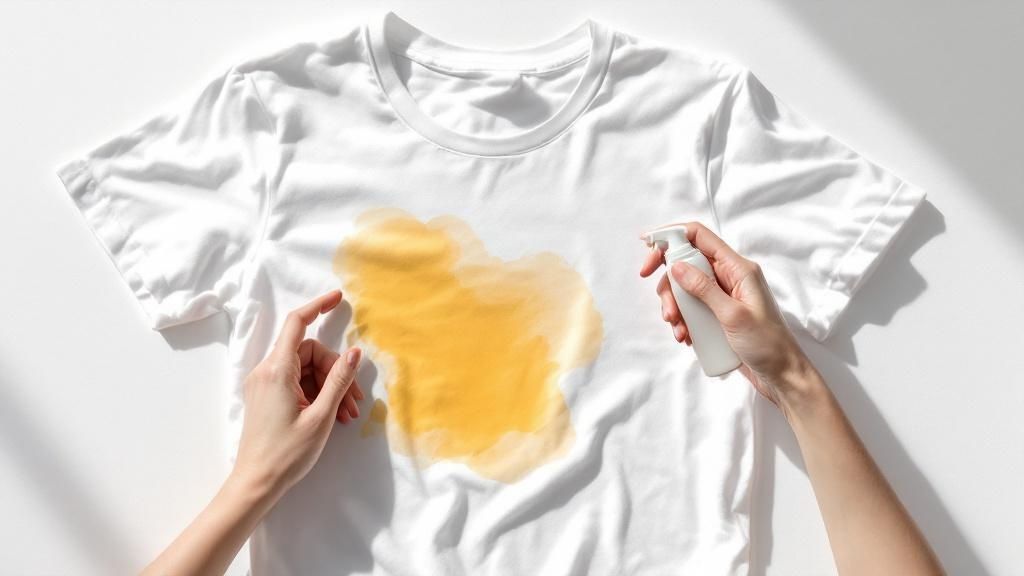
Let's get one common myth out of the way. Sweat itself isn't what's staining your clothes. The real culprit is a chemical reaction that happens right on the fabric.
It all starts when the proteins in your sweat mix with the aluminum compounds found in most antiperspirants. This combination creates a new substance that worms its way deep into the fabric's fibers. Over time, as it's exposed to air, it oxidizes and leaves behind that stubborn yellow stain.
Why Some Fabrics Get Hit Harder
You've probably noticed this reaction is way worse on natural fibers. Materials like cotton, linen, and bamboo are super absorbent, so they just drink up that sweat-and-deodorant cocktail. Synthetics like polyester might not stain as easily, but they have their own problem—they're notorious for trapping the bacteria that cause odor.
The absolute worst thing you can do is throw a sweat-stained shirt in the dryer. The high heat acts like a kiln, basically "baking" that protein-and-aluminum gunk permanently into the fabric. Once that happens, getting the stain out becomes a whole lot tougher, if not impossible.
Key Takeaway: The yellow stain on your shirt isn't just sweat. It’s a chemical bond between your body’s proteins and your deodorant’s aluminum, which gets permanently set by high heat.
Understanding this changes everything. You stop just randomly scrubbing and start a targeted attack. The goal isn't just to "wash" the shirt; it's to break down that specific chemical bond first. This is why pre-treatment is non-negotiable. Without it, you're just washing over the problem, letting the stain get darker and more set-in with every cycle.
Fresh vs Set-In Sweat Stains At a Glance
It helps to know what you're up against. A fresh stain is a completely different beast than one that's been through the dryer a few times. This quick table breaks down the differences.
Recognizing whether a stain is fresh or set-in helps you choose the right game plan. A fresh stain might just need a simple paste, while a stubborn, set-in one is going to require a bit more muscle.
Here's the bottom line:
- The Cause: It’s a mix of sweat proteins and deodorant aluminum, not just sweat.
- The Accelerator: High heat from your clothes dryer locks the stain in for good.
- The Solution: You have to break the stain down with a pre-treatment before it ever sees the inside of your washing machine.
Once you know the enemy, you can pick the right weapons to dissolve the stain and bring your clothes back to life. This little bit of laundry science is the difference between a shirt that’s saved and one that’s headed for the trash.
Powerful Household Remedies That Actually Work
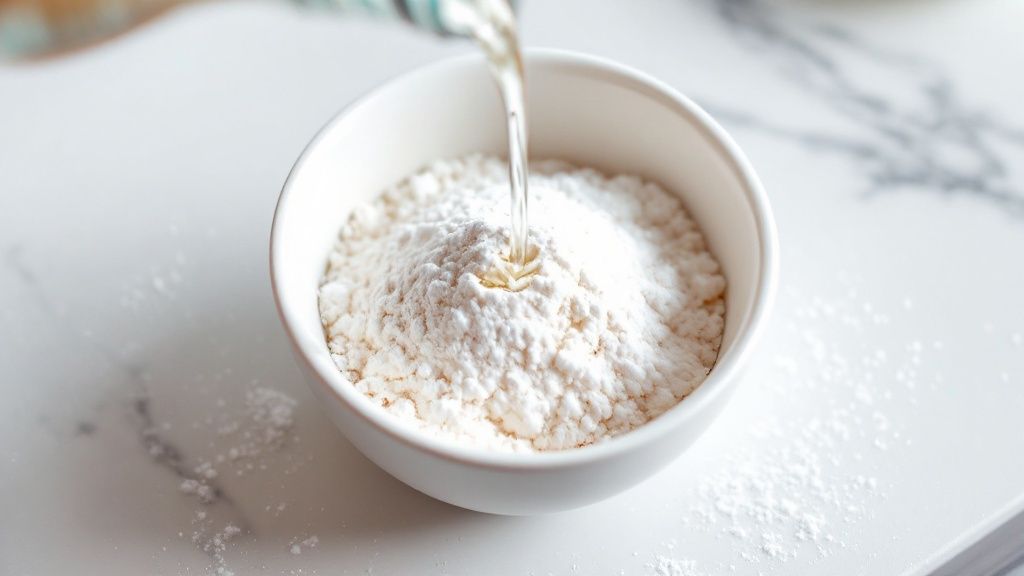
Before you head out to buy a special stain remover, take a peek in your kitchen pantry first. You'd be surprised how many everyday items are absolute powerhouses when it comes to tackling sweat stains. These simple remedies can break down the stubborn chemical bonds that cause that dreaded yellowing, saving your favorite clothes from the donation pile.
Knowing how to use these ingredients is the real secret. It’s not just about what you use, but how you use it. Getting the right paste consistency or the perfect soak dilution is what separates a successful rescue mission from a frustrating afternoon.
The Baking Soda Paste Method
For those tough, set-in stains on both whites and colors, a baking soda paste is my first line of defense. Baking soda is a mild alkali, which is just a fancy way of saying it's perfect for breaking down the acidic parts of a sweat stain without being too harsh on most fabrics. It works especially well on durable materials like cotton.
Whipping up the paste is easy. Just follow this simple ratio:
- Mix four tablespoons of baking soda with one-quarter cup of warm water.
- Stir it all together until you have a thick, spreadable paste, kind of like toothpaste. If it’s too runny, just sprinkle in a bit more baking soda.
Now, slather that paste directly onto the yellowed area, making sure you cover the entire stain. I like to use an old toothbrush or a small scrub brush to gently work the paste right into the fabric's fibers. You want to get it in there, not just let it sit on top. Let the garment sit for at least an hour—and for really gnarly stains, a few hours is even better. After that, just toss it in the wash like you normally would.
The White Vinegar Pre-Soak
When you're dealing with colored clothes, white vinegar is your best friend. A good pre-soak with vinegar helps dissolve both the aluminum from your deodorant and the protein buildup from sweat. Because it’s acidic, it breaks down the stain without stripping the dye, making it a much safer bet than aggressive whiteners.
In a small tub or a clean sink, mix up a soaking solution of one part distilled white vinegar to one part cool water. Submerge the stained part of the garment completely, making sure it’s totally saturated. Let it soak for about 30 to 60 minutes. Don't worry about that vinegar smell; it vanishes completely in the wash. Once it's done soaking, give it a gentle squeeze to get the excess liquid out and then wash it immediately.
Pro Tip: Whatever you do, never mix vinegar directly with bleach. The combination creates toxic chlorine gas. Always make sure you've thoroughly washed a vinegar-soaked item before you even think about using bleach in a later wash cycle.
Hydrogen Peroxide for Brilliant Whites
For white fabrics, nothing beats the brightening power of hydrogen peroxide. Think of it as a mild, oxygen-based bleach that specifically targets and lifts that yellow discoloration. It's much gentler than chlorine bleach, which can ironically make these kinds of protein-based stains even more yellow.
For this method, you'll mix up a potent stain-fighting liquid.
- In a small bowl, combine one part blue dish soap with two parts 3% hydrogen peroxide.
- Mix them gently—you don't want to create a bubble bath.
- Pour the mixture directly onto the stain.
Use your fingers or a soft brush to work the solution into the fabric. You'll probably see it start bubbling and working its magic almost immediately. Let the shirt sit for about an hour before washing it on the coldest water setting the fabric can handle. This targeted treatment is one of the most effective tricks I know for bringing white shirts back to their original, crisp brightness.
When to Reach for a Commercial Stain Remover
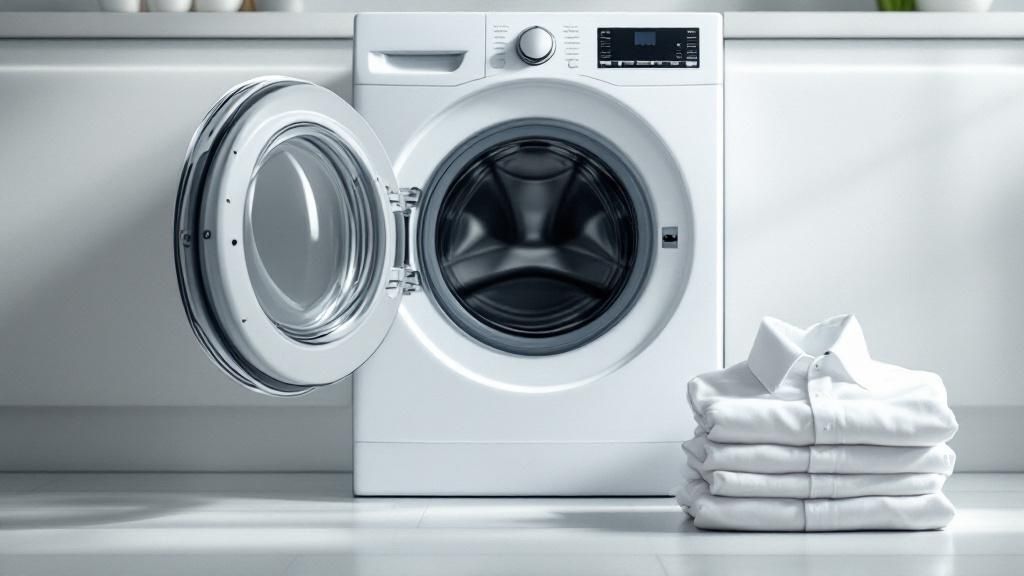
Let's be honest, sometimes those trusty household remedies just don't cut it. You’ve tried the baking soda paste, you’ve given it a good long vinegar soak, and that stubborn yellow stain is still there, mocking you. When you’ve hit that wall, it’s time to bring in the big guns from the laundry aisle.
This is where commercial stain removers really prove their worth. These aren't just super-concentrated detergents; they're specialized formulas engineered to dismantle specific stains at a molecular level.
For sweat stains, you want to look for an enzymatic cleaner. These products are packed with enzymes like protease that are specifically designed to break down the proteins in sweat, which are the root cause of those ugly yellow marks. It’s a targeted attack that regular soap just can't replicate, making it incredibly effective on old, set-in stains.
How to Choose the Right Product
Walking down the laundry aisle can feel a bit overwhelming with all the options staring back at you. To cut through the noise, just flip the bottle over and check the ingredient list.
Here’s what you’re looking for:
- Enzymes: Keep an eye out for "protease" or "amylase." This is your sign that the product is built to demolish biological stains like sweat.
- Surfactants: These are the workhorses that do the heavy lifting, pulling all the loosened grime and oil away from the fabric.
- Oxygen-Based Bleach: Ingredients like sodium percarbonate (the magic behind Oxi-type cleaners) are fantastic for whitening yellowed areas without damaging colors.
Picking the right tool makes all the difference. If you're curious about the science behind it, learning how different stain removers work for every stain type can turn you into a true laundry pro.
When to Call a Professional Dry Cleaner
Even the most powerful store-bought products have their limits. There are a few situations where it’s best to put down the bottle and call a professional.
If the stained garment is made of a delicate fabric—think silk, wool, or rayon—don't risk it. DIY treatments can easily cause shrinking, water spots, or other permanent damage. The same goes for anything valuable or sentimental, like a structured suit jacket or a favorite blazer.
Professional dry cleaners have access to specialized solvents and advanced techniques that can lift stubborn sweat stains safely, preserving the fabric's integrity. Here at Columbia Pike Laundry, we handle these exact situations every day, giving your most cherished items the expert care they deserve.
The global market for stain removers was valued at a whopping USD 22.3 billion in 2023 and is only expected to grow. That tells you one thing: people everywhere are looking for powerful solutions to save their clothes. It’s a universal problem that shows just how much we rely on these products to tackle tough laundry challenges.
A Fabric-By-Fabric Stain Removal Guide
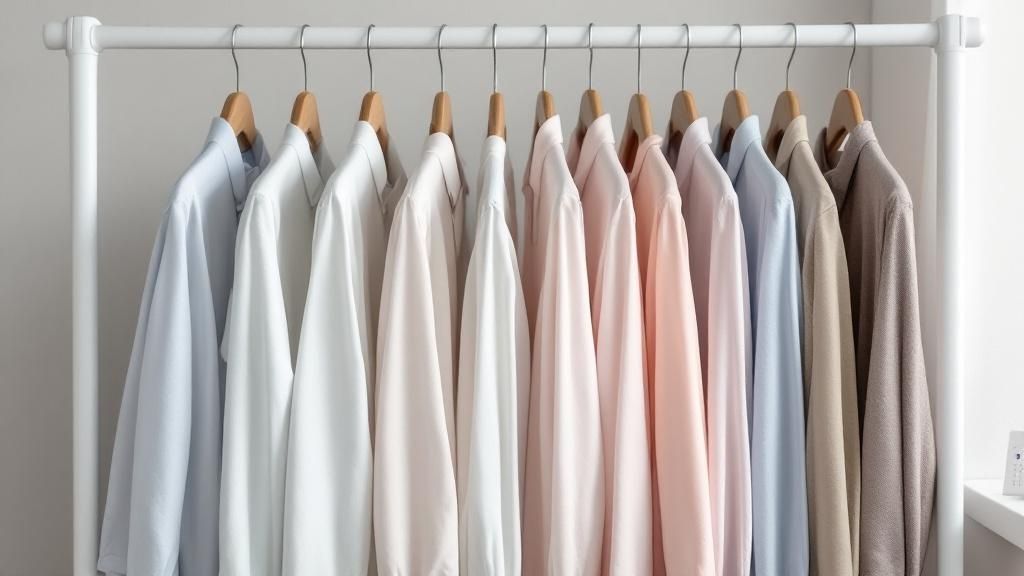
Using the wrong cleaning method on a sweat stain can cause more damage than the stain itself. A treatment that saves a cotton t-shirt might completely ruin a silk blouse. To get those frustrating yellow marks out for good, you have to respect the fabric you're working with.
Think of it like cooking: you wouldn't use high heat for a delicate fish, and the same principle applies to your clothes. Matching the right stain removal technique to the fabric type is the single most important step in rescuing your favorite garments.
For Durable Cottons and Linens
When you're dealing with sturdy fabrics like cotton or linen, you have more options. These materials can generally handle more aggressive treatments without showing signs of wear.
A paste made from baking soda and water or a pre-soak with a hydrogen peroxide solution are both excellent choices. You can use an old toothbrush to gently scrub the stained area, working the solution deep into the fibers to break down the bond between the sweat proteins and deodorant aluminum. Don't be afraid to let the treatment sit for an hour or more before washing in cool water.
For Delicate Silk and Wool
Silk and wool require a much gentler touch. Harsh chemicals or vigorous scrubbing will permanently damage their delicate fibers, leading to stretching, fading, or a fuzzy texture. For these materials, diluted white vinegar is your safest and most effective tool.
Here’s a gentle approach that works wonders:
- Mix a solution of one part white vinegar to four parts cool water.
- Dampen a clean, white cloth in the solution.
- Gently dab the stained area—do not rub. Rubbing can abrade the delicate fibers.
- Let it sit for about 15-20 minutes before rinsing with cool water.
Never use enzymatic cleaners on wool or silk. The enzymes that are so effective at breaking down protein-based sweat stains will also break down the protein fibers of the fabric itself, causing irreversible damage.
For Modern Performance Fabrics
Activewear made from synthetic materials like polyester and spandex presents a unique challenge. While these fabrics are great at wicking moisture away, they are notorious for trapping the bacteria that cause persistent odors, and stains can become embedded in the tight weave.
For these garments, an enzymatic stain remover is essential. The enzymes are specifically formulated to target and dissolve the organic compounds in sweat without harming the synthetic fibers. After treating the stain, wash the item in cold water.
Beyond sweat, understanding how to tackle other common garment challenges is equally important; for example, you may find useful information on effective methods for removing grease stains from clothes. If you need more detailed guidance on these tricky materials, check out our guide on caring for high-performance fabrics.
This attention to fabric care is reflected in the broader market. The global stain removers market was valued at USD 16.86 billion in 2024, with much of that growth driven by the need for specialized solutions for modern fabrics. At the same time, the professional stain removal service market reached USD 6.8 billion, showing that many people prefer to trust their garments to experts. You can see the full research on the stain removers market trends on databridgemarketresearch.com.
How to Prevent Sweat Stains from Forming
Honestly, the best way to deal with a stubborn sweat stain is to stop it from ever happening in the first place. While knowing how to remove them is a great skill, a few simple tweaks to your daily routine can save you a ton of time and frustration. It all starts before you even get dressed.
Since those infamous yellow stains come from a chemical reaction between your sweat and aluminum, one of the easiest fixes is switching to an aluminum-free deodorant. If you're loyal to your antiperspirant, just give it a minute or two to dry completely before you put on your shirt. That little pause keeps the product from immediately smearing onto the fabric, cutting down on the buildup that causes problems later.
Smart Laundry and Wardrobe Habits
Your laundry habits make a massive difference, too. Whatever you do, don't let sweaty clothes fester in the hamper for days. Washing them quickly stops sweat and bacteria from setting deep into the fibers—a crucial step we dive into more in our guide on simple habits to prevent stains and keep clothes fresh.
Here are a few other habits that really pay off:
- Don't Cram the Washer: Your clothes need room to move! Giving them space to agitate means water and detergent can actually get in there and do their job.
- Go Easy on the Detergent: It sounds counterintuitive, but using too much soap can leave behind a residue that traps sweat and dirt, making stains even worse over time.
- Turn Down the Heat: Always tumble dry on low or medium. High heat can bake in potential stains before you even see them, making them nearly impossible to get out.
Another incredibly effective strategy is simply creating a barrier. A classic cotton undershirt will absorb most of the sweat before it ever reaches your favorite button-down or blouse. For an extra layer of defense, especially under delicate or expensive clothing, you could even look into high-quality sweat-proof underwear.
Key Insight: Think of prevention as a long-term investment in your wardrobe. These small, consistent actions protect your clothes, help your favorite pieces last longer, and seriously cut down on the need for emergency stain removal sessions.
Got Lingering Questions About Sweat Stains?
Even with the best techniques, some sweat stains can be maddeningly stubborn. I hear a few questions all the time, especially when people are up against a tough case of discoloration or are worried about a delicate fabric. Getting these answers right can be the difference between saving a shirt and accidentally ruining it for good.
One of the biggest frustrations? A yellow stain that pops right back up after a wash cycle. This almost always means the initial pre-treatment didn't fully break down the bond between sweat proteins and the aluminum in your deodorant. When that still-dirty fabric hits the heat of the dryer, the residue essentially gets baked in, making the stain even more glaring than before.
Step Away from the Chlorine Bleach
I know, I know. It seems like the most logical thing in the world to grab the bleach when you see yellowing on a crisp white shirt. But trust me on this—it's one of the worst mistakes you can make.
Chlorine bleach actually has a chemical reaction with the proteins in sweat. Instead of removing the stain, it can make the yellowing far more intense and lock it into the fabric permanently.
For your whites, always reach for an oxygen-based bleach instead (look for products with sodium percarbonate) or even just a simple hydrogen peroxide solution. These are much gentler and far more effective at lifting the actual stain.
A Little Pro Tip: For those old, set-in stains that have been through the wash-and-dry cycle more times than you can count, patience is your best friend. You might have to repeat your pre-treatment process two or even three times to slowly break down that deeply embedded stain. Don't give up after the first try!
What About Old, Set-In Stains?
So, what do you do with that favorite t-shirt that’s had a dingy-looking stain for months? An old stain that's been baked in by the dryer is a formidable opponent, but it’s not always a lost cause.
Your best shot here is a nice, long soak with a powerful enzymatic cleaner. These formulas are made specifically to go after and dismantle the protein buildup that has fused with the fabric fibers.
- Give It a Good Soak: Fully submerge the stained part of the garment in a concentrated mix of an enzymatic cleaner and cool water. Let it sit for several hours—or better yet, overnight.
- Check and Repeat if Needed: After its long bath, gently rub the area and see how it looks. If that stain is still hanging on for dear life, don't be afraid to drain the water and repeat the soaking process with a fresh solution.
Giving the enzymes that extended time to work is what allows them to really penetrate and dissolve those stubborn, deeply set stains.
When a stain is just too much to handle, or the garment is too valuable to risk experimenting on, don't hesitate to call in the professionals. The team at Columbia Pike Laundry has the expertise and commercial-grade treatments to tackle the most challenging sweat stains, giving your favorite clothes a new lease on life. Schedule your first pickup today!
Popular Blog Articles

Meet the Author
Daniel Logan didn’t start CPL because he loved laundry. He started it because his family was drowning in time debt, and laundry was one of the biggest weights.
Mornings were chaos with two kids under 5. Evenings felt like catch-up. And weekends? Gone to sorting socks and folding piles.
He knew his story wasn’t unique. So he built a business that gave families like his just a little bit of breathing room one load at a time.
With no laundry experience but deep tech skills, Daniel rolled up his sleeves, doing every job himself while building systems that turned it into a modern laundry service that saves customers time, simplifies their lives, and delivers reliability they can count on.
That’s where CPL began. Not from a playbook, but from pain. From one dad trying to buy back time: for himself, and for every household like his.


